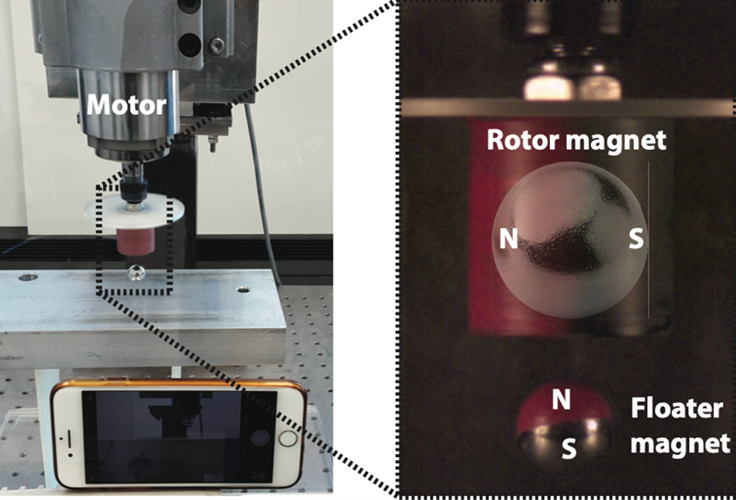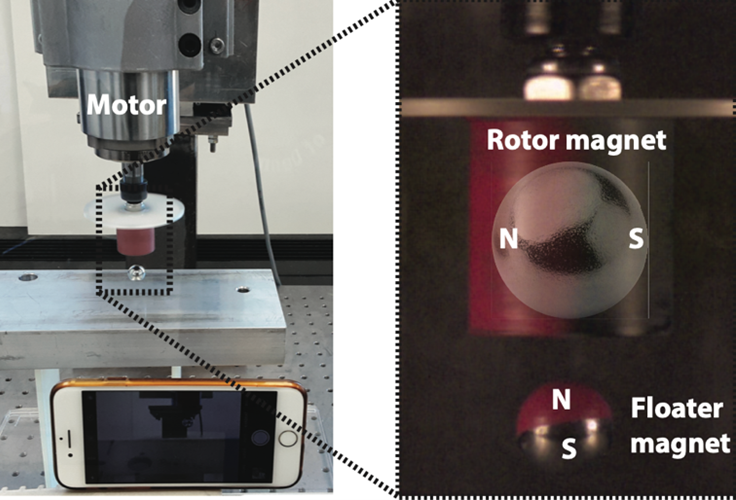How Rotation Drives Magnetic Levitation
Magnetic levitation is common in floating trains and high-speed machinery, but two years ago, a new type of levitation was discovered that uses a rapidly rotating magnet to suspend a second magnet in the air. Researchers have now clarified that this phenomenon originates from slight tilts in the magnetic axes of the magnets relative to their rotational axes [1]. The research team’s experimental and theoretical work reveals surprises about how magnetic levitation works. The new technique could one day be used as a contact-free tool for manipulating objects.
If you bring together two toy magnets with their north poles facing each other, they will repel each other. You might be tempted to try and use that repulsion to counter the force of gravity by placing one magnet beneath the other. However, common experience shows that this balancing act is unstable.
And yet, many systems harness magnetism to achieve levitation by relying on feedback mechanisms that generate stabilizing adjustments to the magnetic fields. Other systems rely on gyroscopic action to stabilize their position. The Levitron toy, for example, is a magnetic top that is spun by hand and then placed above a magnetic plate that exerts a repulsive upward force on the vertically oriented top.
A unique mechanism appears to be behind the new levitation, first demonstrated in 2021 by Hamdi Ucar, an electronics engineer, then at Göksal Aeronautics in Turkey [2]. He attached one magnet—the “rotor”—to a motor so that the magnet’s pole-to-pole axis was oriented perpendicular to the motor’s rotation axis. The rotor was rotated at about 10,000 rpm and held above a second magnet—the “floater”—which spun into motion and levitated upward until it floated in space a few centimeters below the first magnet. Unlike the slow-spinning Levitron, the floating magnet is accelerated to a high rotation speed by the rotor’s motion. The magnetic forces also do more than just counter gravity—they trap the floater, even as the system is turned sideways to make the rotational axis horizontal. While the initial 2021 study presented many experimental configurations and provided an explanation for the levitational forces, it did not pinpoint the mechanism for stabilizing the floater's rotational motion.
Now Rasmus Bjørk of the Technical University of Denmark and his team have filled that gap. They first designed a do-it-at-home levitation experiment using off-the-shelf neodymium magnets, glue, and power tools. But they also performed a more rigorous experiment in which they attached a 19-mm-diameter spherical rotor magnet, with magnetic field strength of around 1.2 tesla, to the drive shaft of a vertical drill whose rotational speed they varied from 7500 to 17,000 rpm. For floaters, the team used various spherical 1.2-tesla magnets with diameters ranging from 5 to 30 mm. Using recording equipment and motion-tracking software, the researchers uncovered the details of the levitated magnet’s motion. “The key highlight in our experiment demonstrating magnetic levitation is how exceedingly simple it is to realize,” says Bjørk.
The researchers made several observations that led them to an explanation of the levitation. Notably, as the floater began rotating, it became locked in frequency with the rotor magnet. Additionally, the levitating magnet assumed a vertical orientation—specifically, its polar axis aligned with the rotation axis but with a few degrees tilt. This configuration, in which the polar axes of the two magnets are nearly perpendicular to each other, would normally be unstable.
To explain this unexpected near-perpendicular configuration, the researchers turned to numerical simulations. They found that the rotor’s spinning magnetic field exerts a torque on the floater, drawing it into a locked rotation. Due to the gyroscopic action of this rotation, the floater’s polar axis tilts only a little, resisting the torque that would draw it into a parallel configuration with that of the rotor. As for the levitation, a small misalignment of the rotor’s polar axis with respect to the horizontal results in a small, static component of the rotor’s magnetic field along the rotation axis. With the static field and near-perpendicular configuration, the magnetostatic force exerted on the floater has both an attractive and a repulsive component that balance each other at a point below the rotor.
Ucar says that the new study “provides precise experimental measurements and analytical evaluations.” One of the team’s conclusions is that induced eddy currents inside the magnets are vanishingly small, and thus these currents cannot be the origin for the levitation. Nevertheless, Ucar suggests that the simulations could be improved by better accounting for the role of eddy currents.
The system has potential applications in magnetic trapping and manipulation, observes Marcel Schuck, CEO and founder of No-Touch Robotics in Zurich, who commercialized a touch-free, magnetic-field-based, gripping robotic arm. He says the rotating magnet system is less complex than an actively controlled magnetic levitation system and incurs lower losses than systems that rely on induced currents.
Correction (18 October 2023): A citation [2] has been added as well as a clarification that this paper contained both a demonstration of the phenomenon and a theoretical explanation of it.
–Rachel Berkowitz
Rachel Berkowitz is a Corresponding Editor for Physics Magazine based in Vancouver, Canada.
References
- J. M. Hermansen et al., “Magnetic levitation by rotation,” Phys. Rev. Appl. 20, 044036 (2023).
- H. Ucar, “Polarity free magnetic repulsion and magnetic bound state,” Symmetry 13, 442 (2021).





